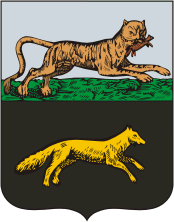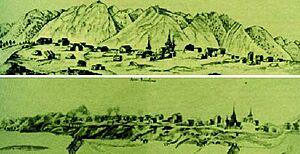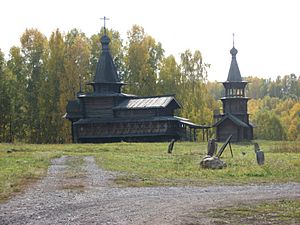Zashiversk facts for kids

Zashiversk (Russian: Зашиверск; Yakut: Зашиверскай) was a town far north in Russia. It was located above the Arctic Circle in what is now the Sakha Republic. The town sat on the right bank of the Indigirka River. This was a spot where the river made a sharp turn.
Zashiversk was started in 1639. It first served as a strong fortress. Later, it became an important center for local government. But in 1803, these government jobs moved to Verkhoyansk. After that, the town faced many outbreaks of a disease called smallpox. By 1898, everyone had left the town. Some say it was empty even earlier, by 1863.
The Spaso-Zashiverskaya church, built in 1700, was moved. Alexey Okladnikov moved it to Novosibirsk. Today, you can see it at the Museum of the Archeological Institute of the Russian Academy of Science.
Contents
Early Settlement and Fortifications
In the late 1500s and early 1600s, Russian groups began exploring the Far Eastern Arctic. In 1639, a group led by Postnik Ivanov, a Siberian Cossack, reached the future site of Zashiversk. They stayed there for the winter.
The location was special. It was below the Shivery (rapids) of the Indigirka River. This is how the town got its name, Zashiversk. It was about 870 kilometers from where the river starts. This spot was a key crossroads. One route followed the river to Kolyma and Chukotka. Another was a land route, called the Tsar's Trail. This trail connected Yakutsk to Nizhnekolymsk.
Postnik Ivanov reported that the area had many valuable sable animals and fish. He also noted a large number of native people living there. Some native Yukagirs even had silver. The `voyevoda` (a type of governor) in Yakutsk decided to create a permanent settlement. This was to take advantage of these resources.
Challenges and Resistance
The Russians collected `yasak` (a tax) from the native people. This tax was paid in sable furs. The Russians often took more than they should. Because of this, native people moved to faraway areas to avoid the unfair taxes.
The Lamuts, a native group, rebelled twice. They attacked Zashiversk in 1668 and again in 1679. But the Russian colonists were strong. They built a wooden stockade around the settlement. This was the only one of its kind on the Indigirka River. The Lamuts were driven away by fortress guns. However, they successfully destroyed a Russian supply group traveling from the Yana River to Zashiversk.
Their resistance continued until 1692. By 1700, the Lamuts and Yukagirs were under Russian control. They also stopped fighting among their own clans.
The Church and Its Preachers
A wooden church, called the Saviour church, was built in 1700. It had a special tented roof shape. In 1741, explorer Dmitry Laptev noted that this church was the only Orthodox church in a vast area. This area stretched from the mouth of the Lena River to Anadyr.
Father Alexey Sleptsov was a famous preacher at the Zashiversk Church. He was an exile, meaning he was sent there as a punishment. He was the son of a former governor of Moscow. In 1735, he was allowed to preach. But he could never leave Zashiversk. He died in 1783 at 74 years old. His son, Mikhail, took over his duties. Mikhail lived to be over 87.
A Time of Growth and Trade
Zashiversk grew into a busy marketplace. Its yearly fair brought traders from all over the Far East. In 1786, the government made it an `uezd` (a district) center. This brought more government workers and their helpers. Zashiversk became a proper town. It had a city hall, a prison, a police force of thirty Cossacks, and a tavern.
The town's population reached 500 people. This included 64 military members and 8 clergymen. Explorers Gavril Sarychev and Joseph Billings wrote about this busy time. They also noted the kindness of the local `ispravnik` (police chief), Ivan Banner. Banner was from Denmark but worked for Russia. He managed daily police tasks. He also worked to convince the Chukchi to become Russian citizens. He carefully watched foreign traders in the area. Later, he joined the Russian-American Company.
Zashiversk received its own Coat of arms in October 1790. This was part of the Irkutsk Governorate. The coat of arms showed a golden fox on a black background. This symbolized fox hunting, which was how people in Zashiversk made a living.
However, too much hunting in the 1700s reduced the number of animals. Fewer furs meant less trade. This led to the town's decline. In 1803, Zashiversk lost its importance as a marketplace. The `uezd` was closed, and all government jobs moved to Verkhoyansk.
The Town's Decline
Ferdinand von Wrangel, an Arctic explorer, visited Zashiversk in October 1820. He noted that the town had grown to about thirty permanent houses after 1786. Before that, people lived in `yurta` (round tents). But after the government jobs moved away, Zashiversk "plunged into its former misery."
By 1820, the town had shrunk to only five houses. There were two Russian families, a Yakut postmaster, and the Orthodox missionary father Mikhail and his brother. Wrangel was surprised to find the local church well-kept. Father Mikhail was 87 years old. He had preached in the Arctic for sixty years. He had converted about 15,000 native people. He could still ride a horse across his huge parish and hunt in the mountains. Mikhail was the only person there who could grow cabbage and root vegetables during the short Arctic summers.
The Yakuts in Father Mikhail's area were divided. There were richer nomads who raised horses and cattle. And there were poorer settlers, called "River Yakuts." These River Yakuts lived along the rivers and survived only by fishing. Their only animals were sled dogs. Zashiversk still had some importance for supplies. Wrangel's visit happened when a government caravan passed through. It carried salt and flour to Nizhnekolymsk. The Yakuts provided horses for this caravan.
John Dundas Cochrane visited Zashiversk in December 1822. He walked there and described it as "the most dreary and desolate" place he had ever seen. He found only seven people living there. These included two clergymen, a widow, two non-commissioned officers, a postmaster, and a trader. Cochrane praised their kindness. They gave him "plenty of fish," which he called "the greatest delicacy."
A Ghost Town Emerges
Wrangel and Cochrane visited Zashiversk after the first smallpox outbreak in 1816. A second outbreak in 1840 killed almost everyone left. Some stories say only one girl survived.
The emptying of Zashiversk led to a Siberian legend. Traders found a chest left at the fairground. A `shaman` (a spiritual healer) said not to open it. But an Orthodox priest agreed to open it. When the traders opened the chest, they supposedly released the grim reaper.
According to George Kennan, in 1879, the government still thought Zashiversk existed. They sent Hermann Schiller, a political exile, on a 3,700-mile walk to Zashiversk. Only then did the government learn the town was gone. Schiller was then sent on another year-long journey to Srednekolymsk. A similar story was told by Adam Szymansky in his book A Pinch of Salt.
Officially, Zashiversk was removed from maps only in 1890. Harry de Windt traveled through the area in 1902. He saw Zashiversk abandoned, with its ruins still standing. He noted that the town was still marked on British maps and an 1883 Russian map.
Modern Discoveries
In 1969, archaeologists led by Alexey Okladnikov found and studied the remains of Zashiversk. Archaeologist Nikolay Zhurin said that polar pilots told Okladnikov about the church. They wondered how it could survive in such a wild, frozen place.
Okladnikov organized the 1969 trip. He found the church, which had been left alone for about a century, in good condition. A second trip in 1971 carefully took apart the wooden church. They even got curious helicopter pilots to help lift the whole tented roof. The parts were then shipped to Akademgorodok.
Volunteers slowly put the church back together. This was done at the site of a future open-air museum (54°51′0″N 83°10′43″E / 54.85000°N 83.17861°E). As of 2006, the inside of the church was not yet restored. It had not been made ready for religious services again.
Okladnikov and his team wrote an important book about the town. It was called Ancient Zashiversk. A copy of the Zashiversk church has been built. You can see it at the Sottintsy open-air museum in the Ust-Aldansky Ulus of the Sakha Republic.



